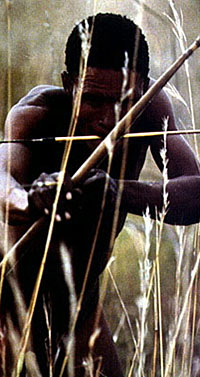
Custom and tradition, which are learned by imitation or embodied in the legends and myths of the band, determine behavior and values. The rules are simple and clear and understood by all. Social pressure by the group enforces proper behavior. There is little need for coercion. There is also little in the way of "private life" as we would understand it. In fact, hunter gatherers would very probably not understand the concept.
Hunter-Gatherer Populations
Because of their mobile way of life and their methods of subsistence, hunting and gathering economies can support only a low child-to-adult ratio. Interestingly, the birth rate of such groups tends to remain low, although controlled by mechanisms that are not fully understood. There appear to be natural checks on fertility, so that the human population tends to stay in balance with available resources.
The stable population size which tends to characterize hunter-gather groups points to one of the most fundamental differences between this mode of life and the more complex way of life based on agriculture. Agricultural populations tend to expand dynamically, as we shall see in the next section of the module.
| Previous Page | Next Page | Ag Rev Home |